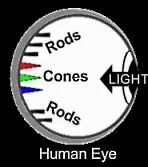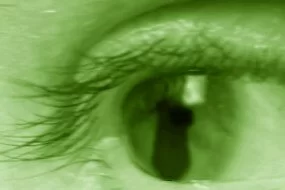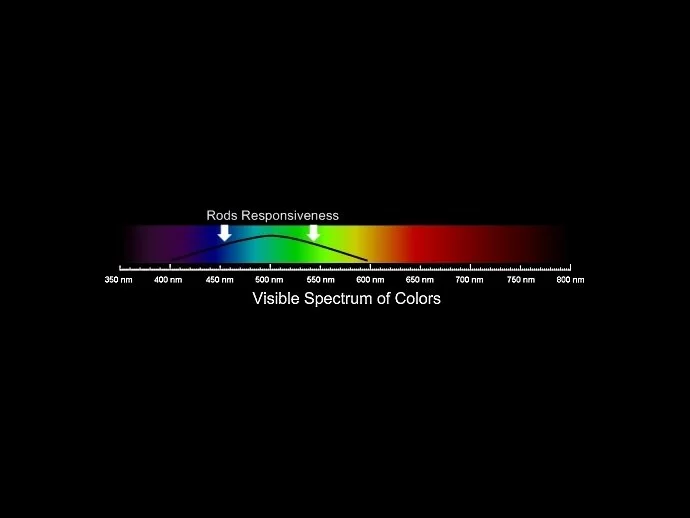Can we better see ghosts by using our peripheral vision?
Many sightings of ghosts are reported as being seen out of the “corner” of people's eyes through what's called our "peripheral vision." So, we wanted to explore peripheral vision and ghosts because some wish to discredit the human ability to accurately see entities through anything but our central vision. Can ghosts be detected through the sides of our eyes? Let's explore...
The argument against accurately seeing ghosts through peripheral vision has gained strength because we can be tricked into seeing things that are not there by our brains. While it is common for the brain to gather snapshots from the periphery and then “fill in the blanks,” (known as the phenomenon of “seeing something that isn't there"), it is still possible that peripheral vision can enhance our ability to see and detect ghosts.
 Because many reports of ghosts seem to occur during the evening (maybe because people prefer to ghost hunt at night), allow me to briefly explain human eyesight in low-light conditions. Receptor cells in the back of the eye can be divided up into two types: rods and cones. Our central vision, used for detailed viewing, relies upon the cones; peripheral vision depends upon the rods. The differences between these photoreceptor cells give us different capabilities within our collective eyesight; and for viewing ghosts, that could be important to know. For example, when seeing in dark environments, it is well known that our central vision is weak (due to reliance upon bright light) while peripheral vision is much stronger. The rods in our eyes, used for seeing the periphery, operate much better during low-light conditions than cones; this allows the eye to detect light that is a billion times dimmer than bright sunlight!
Because many reports of ghosts seem to occur during the evening (maybe because people prefer to ghost hunt at night), allow me to briefly explain human eyesight in low-light conditions. Receptor cells in the back of the eye can be divided up into two types: rods and cones. Our central vision, used for detailed viewing, relies upon the cones; peripheral vision depends upon the rods. The differences between these photoreceptor cells give us different capabilities within our collective eyesight; and for viewing ghosts, that could be important to know. For example, when seeing in dark environments, it is well known that our central vision is weak (due to reliance upon bright light) while peripheral vision is much stronger. The rods in our eyes, used for seeing the periphery, operate much better during low-light conditions than cones; this allows the eye to detect light that is a billion times dimmer than bright sunlight!
On the down side, seeing things out of the corner of our eyes does produce images with less clarity in most cases; but this is not always true. Although peripheral vision is not used to distinguish colors, it is much better at detecting motion. The combination of seeing no color coupled with excellent ability at detecting movement could be another reason many have reported seeing dark, black shadow ghosts move from the corners of their eyes. If you still think this portion of our eyesight has little merit, then you will need to argue with the military. It is well known by the US Army that faint objects in the dark are better viewed by our peripheral vision. Troops are often taught not to focus on objects directly at night but to direct their vision to one side in order to see them better. Coincidently, contact lenses would be preferred over glasses in order to maintain a clear path to the periphery.
Different Frequencies & Wavelengths of Light
Humans see the range of light known as the visible light spectrum. The typical human eyeball can see the wavelength range of 380-750 nanometers (see chart above). The various wavelengths in the spectrum of visible light are seen as different colors by the three types of photoreceptor cones in our central vision, spanning the full range of hues. Peaking near the center of the visible spectrum at about 500 nm, the vision of our photoreceptor rods is sensitized to the wavelengths of violet, blue, green and yellow (though they cannot see them as colors but in shades of gray). The longer wavelengths of orange and red are completely eliminated from the peripheral part of our eyesight. Knowing this, we could say our peripheral vision is actually more focused toward monitoring more of the middle range of visible light and not interfered with by higher wavelengths. Could this be a factor that might somehow make our peripheral vision better equipped to see ghosts at times? Maybe...
 Although we have shared our thoughts about seeing ghosts through our peripheral vision, it is also possible to see ghosts through our central vision – shadow ghosts included. Our point is that there doesn't seem to be one simple answer that explains the mystery of when, where, how and why we see ghosts. Therefore, we need to keep an open mind.
Although we have shared our thoughts about seeing ghosts through our peripheral vision, it is also possible to see ghosts through our central vision – shadow ghosts included. Our point is that there doesn't seem to be one simple answer that explains the mystery of when, where, how and why we see ghosts. Therefore, we need to keep an open mind.


